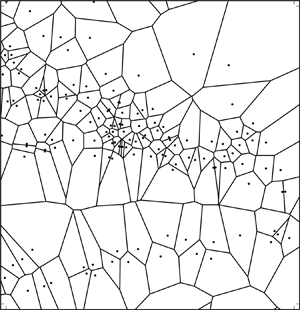Particle laden turbulence: Analysis of clustering using multiscale techniques
Abstract: Multiscale statistical analyses of inertial particle distributions are presented to investigate the statistical signature of clustering and void regions in particle-laden incompressible isotropic turbulence.
Three-dimensional direct numerical simulations of homogeneous isotropic turbulence at high Reynolds number (Reλ≳200) with up to 10^9 inertial particles are performed for Stokes numbers ranging from 0.05 to 5.0.
A finite-time measure to quantify divergence and the rotation of the particle velocity by determining respectively the volume change rate of the Voronoi cells and their rotation is proposed. For inertial particles the probability distribution functions (PDF) of the divergence and of the curl deviate from that for fluid particles. Joint PDFs of the divergence and the Voronoi volume illustrate that the divergence is most prominent in cluster regions and less pronounced in void regions. For larger volumes the results show negative divergence values which represent cluster formation and for small volumes the results show positive divergence values which represents cluster destruction/void formation. Moreover, when the Stokes number increases the divergence takes larger values, which gives some evidence why fine clusters are less observed for large Stokes numbers. Finally, the PDFs of the particle vorticity have much heavier tails compared to the fluid vorticity, and the extreme values increase significantly with the Stokes number.
Orthogonal wavelet analysis is then applied to the computed particle number density fields. Scale-dependent skewness and flatness values of the particle number density distributions are calculated and the influence of Reynolds number Reλ and Stokes number St is assessed. For St∼1.0, both the scale-dependent skewness and flatness values become larger as the scale decreases, suggesting intermittent clustering at small scales. For St≤0.2, the flatness at intermediate scales, i.e. for scales larger than the Kolmogorov scale and smaller than the integral scale of the flow, increases as St increases, and the skewness exhibits negative values at the intermediate scales. The negative values of the skewness are attributed to void regions. These results indicate that void regions at the intermediate sales are pronounced and intermittently distributed for such small Stokes numbers.
This is joint work with Thibault Oujia (Aix-Marseille U, France), Keigo Matsuda (JAMSTEC, Japan) and Katsunori Yoshimatsu (Nagoya U, Japan).
References.:
T. Oujia, K. Matsuda and K. Schneider. Divergence and convergence of inertial particles in high Reynolds number turbulence. J. Fluid Mech., 905, A14, 2020.
K. Matsuda, K. Schneider and K. Yoshimatsu. Scale-dependent statistics of inertial particle distribution in high Reynolds number turbulence. Phys.
Rev. Fluids, 6, 064304, 2021.

